
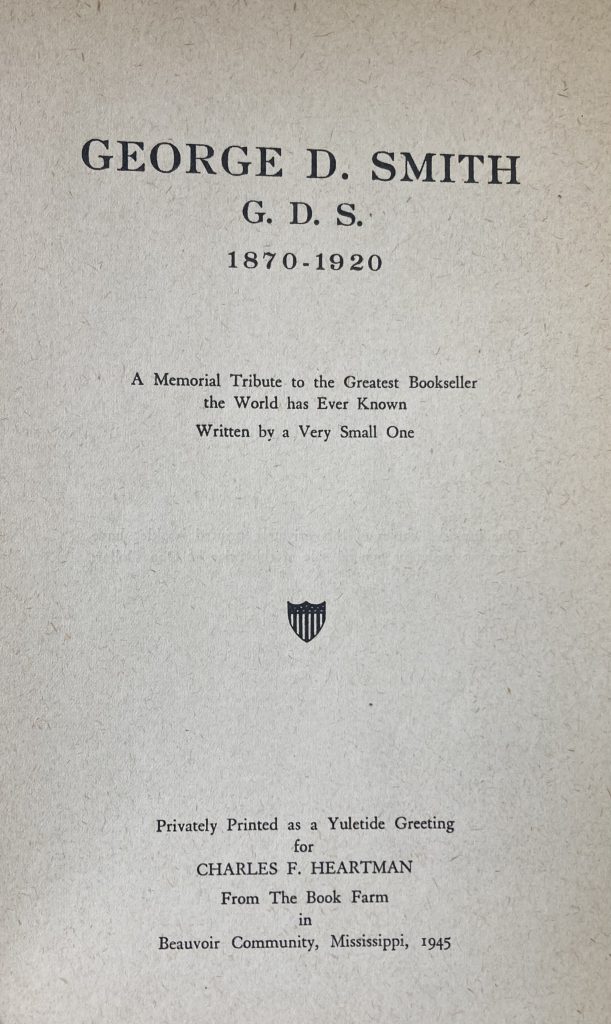
simply messing about in books


recent reading : early june
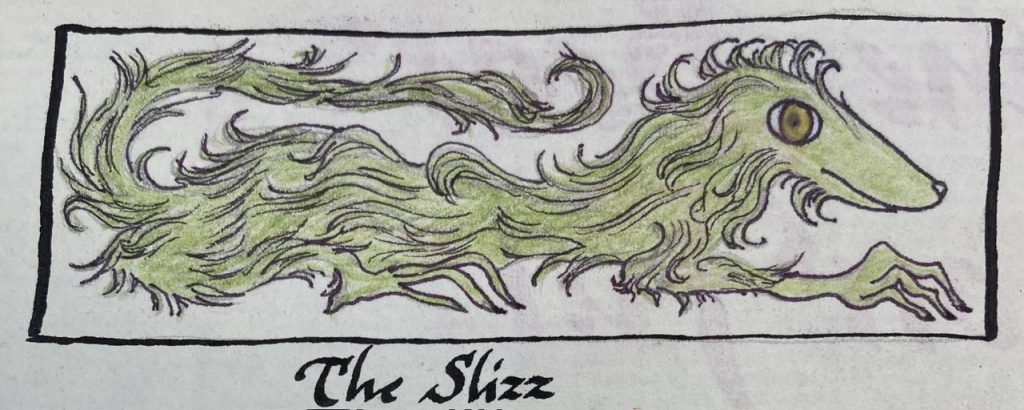
— Tom LaFarge. The Crimson Bears. Part I. Sun & Moon Press, [1993].
——. A Hundred Doors. The Crimson Bears. Part II. Sun & Moon Press, [1994, i.e., 1995].
/ I have loved The Crimson Bears ever since I first encountered them, I read read them aloud to the offspring, and wrote about them, and about the early career of Tom La Farge (1947-2020) here : https://endlessbookshelf.net/bargeton.html
Am re-reading these in advance of the re-issue by Tough Poets Press. This is fabulous news !
— Paul McAuley. War of the Maps [2020]. VG [Gollancz], 2021.
/ what a writer ! McAuley makes it happen. Everything is otherwise but there are echoes & riffs of Beckett early on, and I see everywhere threads of Le Guin (The Dispossessed, in particular) ; and now, far out in the world ocean, a glimpse by the lucidor protagonist of world wanderers (an albatross by any other name) conjures up all the ripples of Coleridge ; and the deployment of Chekov’s dictum is deft and sudden. McAuley’s unexpected turns are shocking, deeply satisfying, the work of a magician who sets up his effects with precision and perfect timing.
— — —
this just in
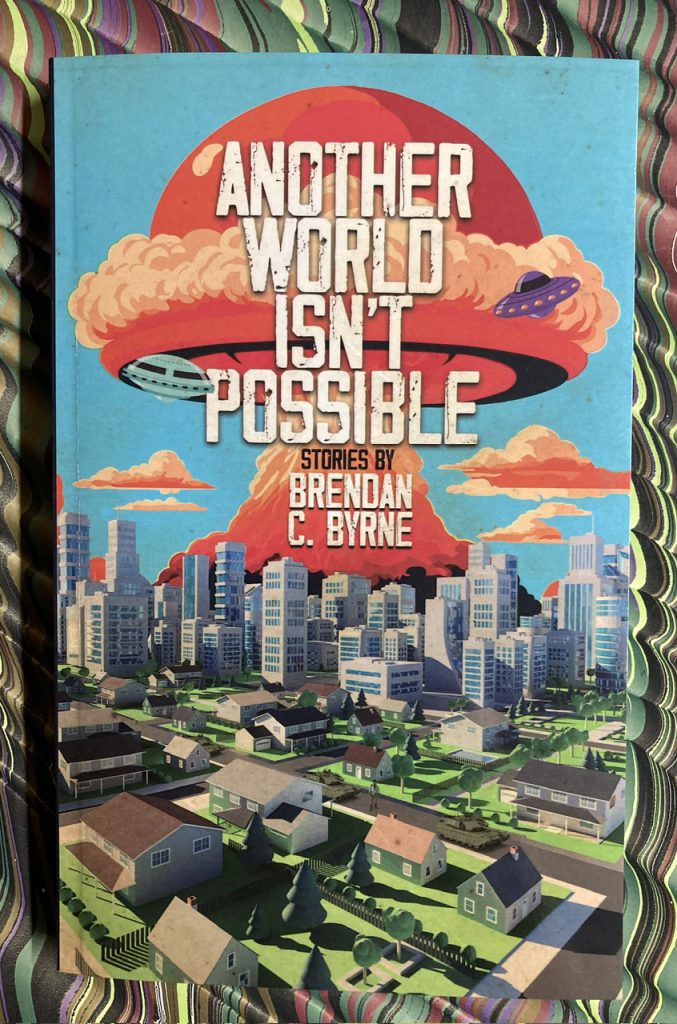
— Brendan C. Byrne. Another World Isn’t Possible. Stories. 226, [4], [6, ads], [3, blank], [1, imprint] pp. [Melbourne :] Wanton Sun, [2025 : POD, Chambersburg, Penna., 5 June]. Cover by Matthew Revert.
/ I know a few of these stories (even published one), but wow ! have I been looking forward to this collection. Stylish design !
/ from the blurbs : “Ruthlessly hip, transreal surreal. Worth your time.” — Rudy Rucker
— — —
various :
— Brian Eno and Bette Adriaanse. What Art Does. An Unfinished Theory [2024]. Faber, [2025].
/ serious, playful thinking about the what and why of art.
/ the Endless Bookshelf reminds readers of the Humument fragment by Tom Phillips, “the reader is the artist” :
https://temporary-culture.com/conversation43e/
— Colin Wilson. Jorge Luis Borges. Cover with portrait drawing by Hugo Manning. London : Village Press, 1974.
/ literary journalism by Colin Wilson, reductive in tone, and in the end more interested in himself than in the writings of Borges
— John Shen Yen Nee and S J Rozan. The Railway Conspiracy. Soho Crime, [2025].
— William S. Reese. The Best of the West. 250 Classic Works of Western Americana. William Reese Company, 2017.
/ succinct illustrated discussion of books (1555-1941) that chart the exploration and settlement of the American West.
— — —

— Mark Hanusz. Kretek. The Culture and Heritage of Indonesia’s Clove Cigarettes. [With a foreword by Pramoedya Ananta Toer]. Illustrated in color throughout. [xx], 203 pp. Equinox Publishing, 2000.
/ heard about this from a new acquaintance who grew up in Indonesia and described the sensory rush of memories arising, years later, from finding a discarded packet of clove cigarettes. Never smoked them myself but the olfactory memory is there. Bought two copies, one for a friend interested in the history of smoking and related phenomena.
— — —
— Heiress. Sargent’s American Portraits. 16 May – 5 October 2025 [Cover title]. [Foreword by Richard Ormond]. English Heritage | Kenwood, 2024.
/ Catalogue of an exhibition of 18 portraits by John Singer Sargent, with summery biographies of the American heiresses who married into the British inner circles and aristocracy. An excellent, compact show. Ormond is author of the Sargent catalogue raisonné.
recent reading :
— John James Audubon. My Style of Drawing Birds. Introduction by Michael Zinman. The Overland Press for the Haydn Foundation, 1979.
Facsimile and transcription of a fascinating manuscript, “Audubon’s definitive statement on the achievement to which he devoted his life”.
— Arthur Freeman and Janet Ing Freeman. Anatomy of an Auction. Rare Books at Huxley Lodge, 1919. The Book Collector, 1990.
How books were really sold in Britain, once upon a time. Discussion of the “ring” in action at a country house sale, based on documentary evidence of the “knock out” and “settlement” among participating dealers : a Shakespeare First Folio sold for £100 in the room and £1,550 in the third round (with the surviving participants dividing the difference between them). This sort of arrangement was abolished by law in 1927 but continued illegally into the 1950s.
— Frank Baker. Miss Hargreaves. A Fantasy. Eyre and Spottiswoode, 1940.
Bonkers : a poetry hoax, what can possibly go awry ?
— Pramoedya Ananta Toer. All That Is Gone. Translated from the Indonesian by Willem Samuels. Hyperion East, [2004].
Short stories ranging in time from the colonial period through the Japanese occupation and early independence. The title story is episodic and invokes the transitory nature of things.
— — —
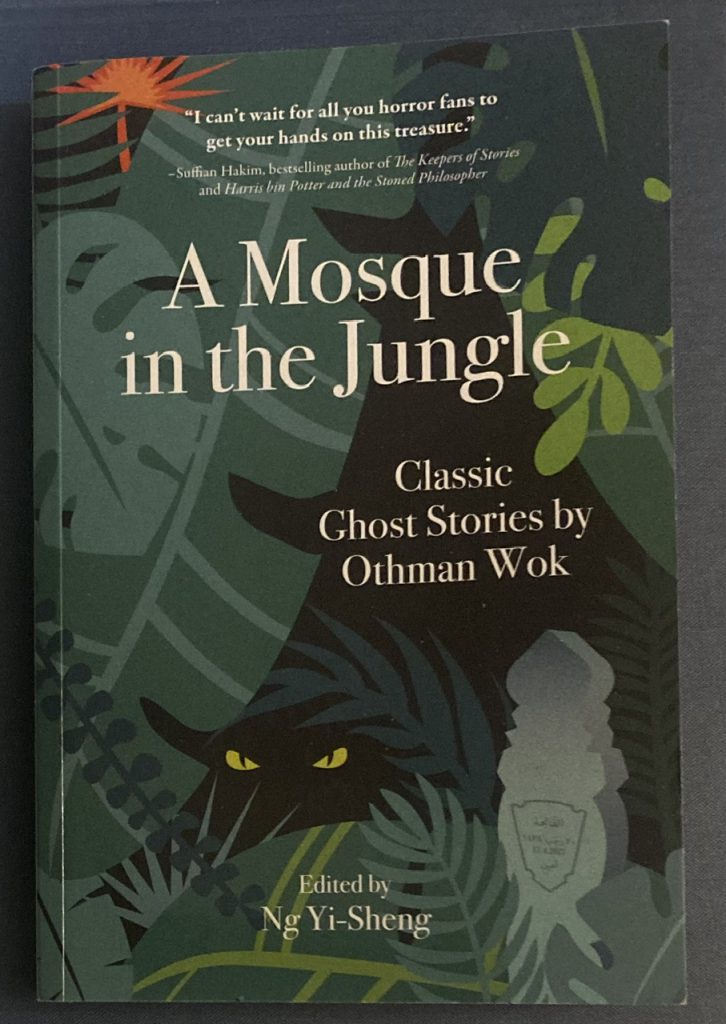
— Othman Wok. A Mosque in the Jungle. Classic Stories . . . . Edited by Ng Yi-Sheng, with translations by M M Basalamah and Tan Poay Lim. Epigram, [2021].
— Clarence Wolf. Fifty Years a Bookseller or, The Wolf at Your Door. Second, expanded edition. Privately printed, 2025.
/ the first edition (2022) vaulted right into the top five bookshop memoirs (joining the ranks of Tim d’Arch Smith’s The Times Deceas’d and Not 84 Charing Cross Road by Driffield, and two others where I will concede there is room for debate) ; the new edition adds more anecdotes and an index. Outstanding and witty !
— — —

‘not our family’s first float trip through an abandoned mine’
— Sarah Kendzior. The Last American Road Trip. Flatiron Books, [2025].
Well written and intensely engaging book, family travels in an uncertain America. Kendzior is direct and unflinching and honest. She has travelled to some remarkable places in what the French would call “l’Amérique profonde”, deep in the heart of the heart of the country. Kendzior is brave and funny and clear-eyed about America in our time.
— Bjørn Berge. Nowherelands. An Atlas of Vanished Countries 1840-1975. [Translated from the original Norwegian by Lucy Moffatt]. Thames & Hudson, [2017].
An excellent travel book to odd corners of the globe, anchored by postage stamps and illuminated by literary citations. I wondered at the omission of one small country until I saw the date of the extinction of Biafra in the original title, Landene som forsvant, 1840-1970 (Countries that vanished ?), which answers the question. Of the fifty, more than a dozen were unknown to me, and another six or seven only as names on a map. This book made me think of The World of Donald Evans ; and Secret Europe by John Howard and Mark Valentine (2012), who re-write the imaginative geography of continental Europe in the interwar years* in a gorgeous book fragrant with “that air of mystery, transgression, and foreboding” identified by Michael Dirda.
——
* and in the perpetual life during wartime all years past now seem interwar years
— — —
— John Scalzi. Old Man’s War [2005]. [With a new introduction]. Tor, [2024].
— Ian Rankin. Midnight and Blue. An Inspector Rebus Novel. Mulholland Books, [2024].
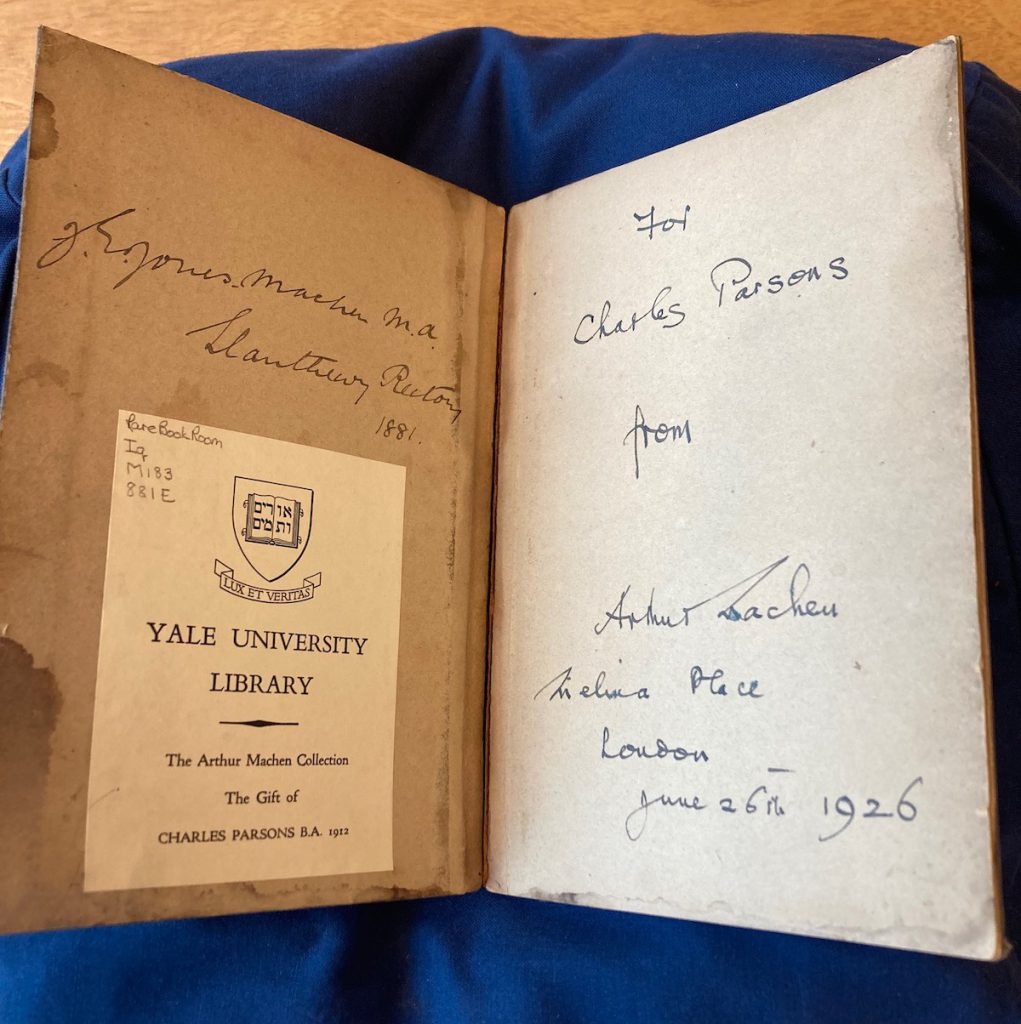
Arthur Machen’s first book, Eleusinia, by a former member of H. C. S., is a sequence of poems celebrating pre-Christian mysteries in the Athens of the young author’s imagination. The pamphlet was printed in Hereford in 1881, and is known from one copy preserved at the Beinecke Library, Yale University. The copy is from the collection of Charles Parsons (Yale class of 1912), who was one of the lenders to the Harry Marks exhibition in 1923. Eleusinia was not, however, exhibited in 1923, for at the time it was still in the author’s possession. But by 1926 his circumstances had changed, and when it happened that one of the American collectors with whom Machen had been corresponding was visiting London, Machen agreed to receive him and to sell his copy of Eleusinia. The picture above shows the pastedown with the Charles Parsons ’12 gift bookplate, and above it is the signature of Arthur Machen’s father John Edward Jones Machen, M.A., Llanthewy Rectory, 1881. Machen’s father paid for the printing of the book, and in his copy he pasted a clipping, a tactful, encouraging press notice, identified as by “Lewis Sergeant Esqre in Hereford Times”. Lewis Sergeant (1841-1902) was a journalist and author and a close friend of the Machen family ; Machen stayed in his house in Turnham Green when he first came up to London. On the flyleaf opposite is the author the inscription at the time of the sale, “For Charles Parsons from Arthur Machen, Melina Place, London, June 26th 1926”. Parsons saved his correspondence with Machen, and the receipt (shown below) is preserved in the files at Beinecke (Gen MSS 256, Box 1 folder 3).
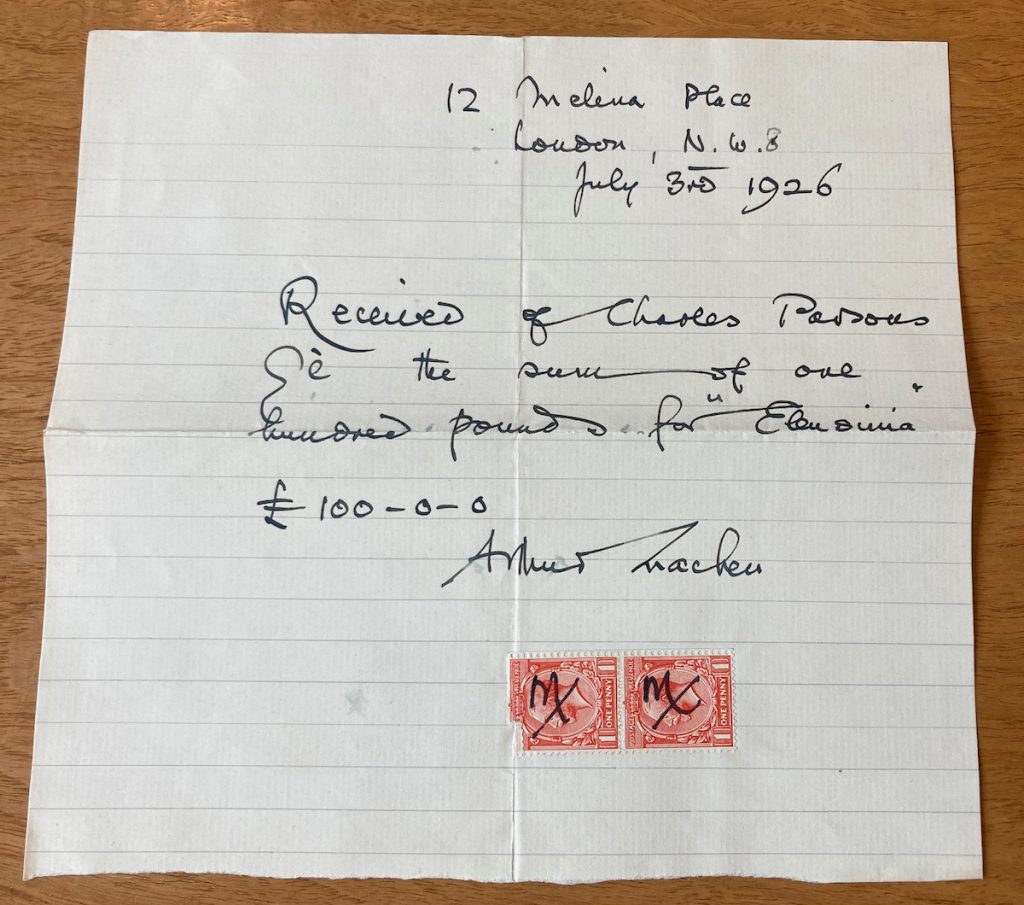
Bookselling and, for that matter, book collecting, are in my blood. Soon after I joined my father at Bertram Rota Ltd. we came across a sophisticated copy of a modern first edition (in fact, first edition sheets removed from a soiled binding and put into an immaculate binding case from a slightly later printing in a crude and misguided attempt to increase the value). Even now, thirty-seven years later, I still remember the intensity of my father’s anger as he explained to me what had happened and why. Speaking perhaps of private rather than institutional collecting, he said that we booksellers made the rules and also acted as referees. If we cheated, everything became meaningless.
— Anthony Rota, on The Texas Forgeries, in : Forged Documents (1990)
— — —
I was impressed for the ten thousandth time by the fact that literature illuminates life only for those for whom books are a necessity. Books are unconvertible assets, to be passed on only to those who possess them already.
— Anthony Powell, The Valley of Bones (1964)
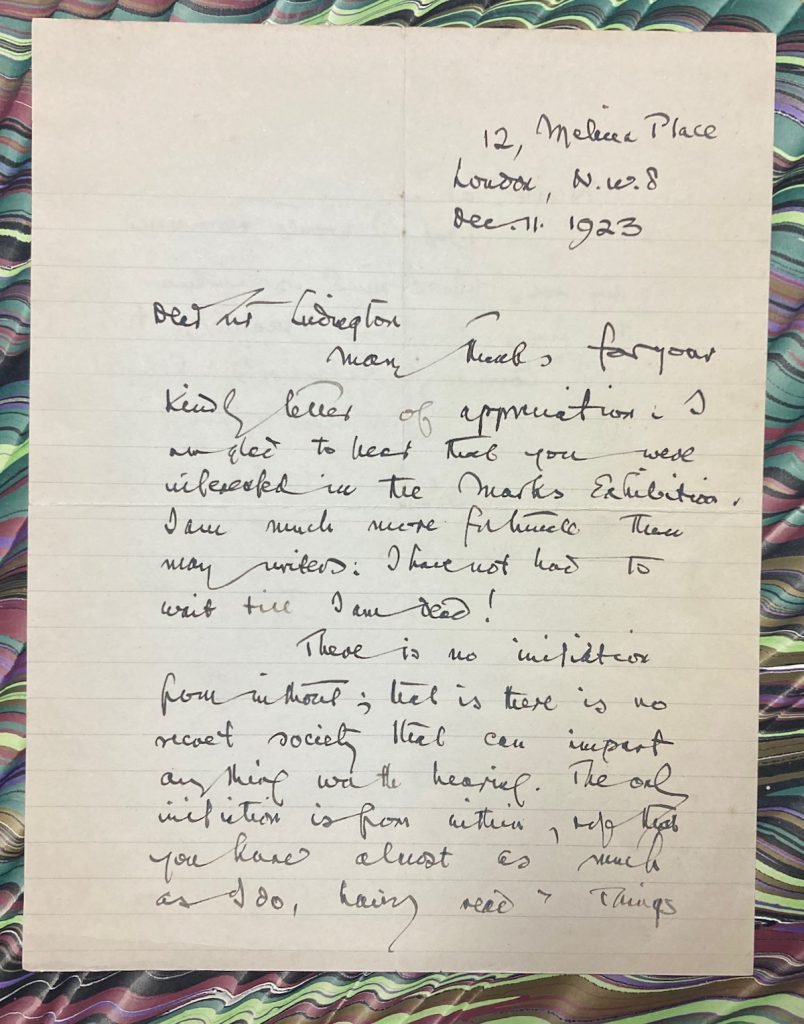
One hundred years ago, on 11 December 1923, Arthur Machen wrote a letter to a young American fan. The letter becomes more interesting with a little context. In the autumn of 1923, New York bookseller Harry F. Marks issued his catalogue 11* and sent out invitations to a display of manuscripts and books of Arthur Machen. The background to this exhibition is notable. In 1922, Machen’s old friend and publisher Harry Spurr had brought manuscripts, proofs, and unpublished materials over to America and sold them to Harry F. Marks, who ran a well-established business for the New York carriage trade, and to Walter M. Hill of Chicago, another book dealer of national reputation. As John Gawsworth notes in The Life of Arthur Machen, “Marks who sold the pick of his collection by private treaty before issuing his 1923 catalogue still had some forty priced items to dispose of there at a total price of some $3,000. [. . .] the ‘boom’ was on”. **
The Life of Arthur Machen transcribes a letter dated 15 October 1923 that had been reproduced as pages three and four of the invitation :
Dear Mr Marks,
You tell me that you are holding an Exhibition of my books and manuscripts at your place in Broadway, New York. I hope your citizens will be interested.
But I cannot help thinking of a visit that I paid this last summer to my old home Llanddewi Vach Rectory in Monmouthshire. I left in September 1887; and had not been there since. The orchards that my father planted had grown into a wood; nothing else was much changed. But the old place brought back to my mind the old days, the days when, quite unknown and solitary, I worked night after night at The Chronicle of Clemendy in the room that looked out on those orchards and above and beyond them to Bertholly on the slope of Wentwood.
It is a far cry from the room at Llanddewi Vach to the Broadway Exhibition.
Yours sincerely,
Arthur Machen
12, Melina Place
London N.W.8
Machen was characteristically diffident about what New Yorkers would make of his work, but the letter from Machen illustrated above shows that the exhibition resonated with some visitors. The recipient of the letter was New York lawyer and bibliophile George Franklin Ludington (1895-1949, Johns Hopkins 1916, Harvard Law 1920), who had written a wistful fan letter to the author after his visit to “a little book dealer (but by no means an inconsequential one) of this city”. Ludington retained a draft or fair copy of his letter, in which he mentions that in his youth in rural Maryland he had “climbed through the brambles that foot of the Hill of Dreams”, and then concludes with a supplication for the secrets bestowed upon Machen by A. E. Waite or others.
Machen’s response is gracious and tricky and illuminating, and then takes a curious meander into the literary undergrowth. I know the name Coventry Patmore, and so do perhaps a half a dozen others, too; but it is a curious recommendation :
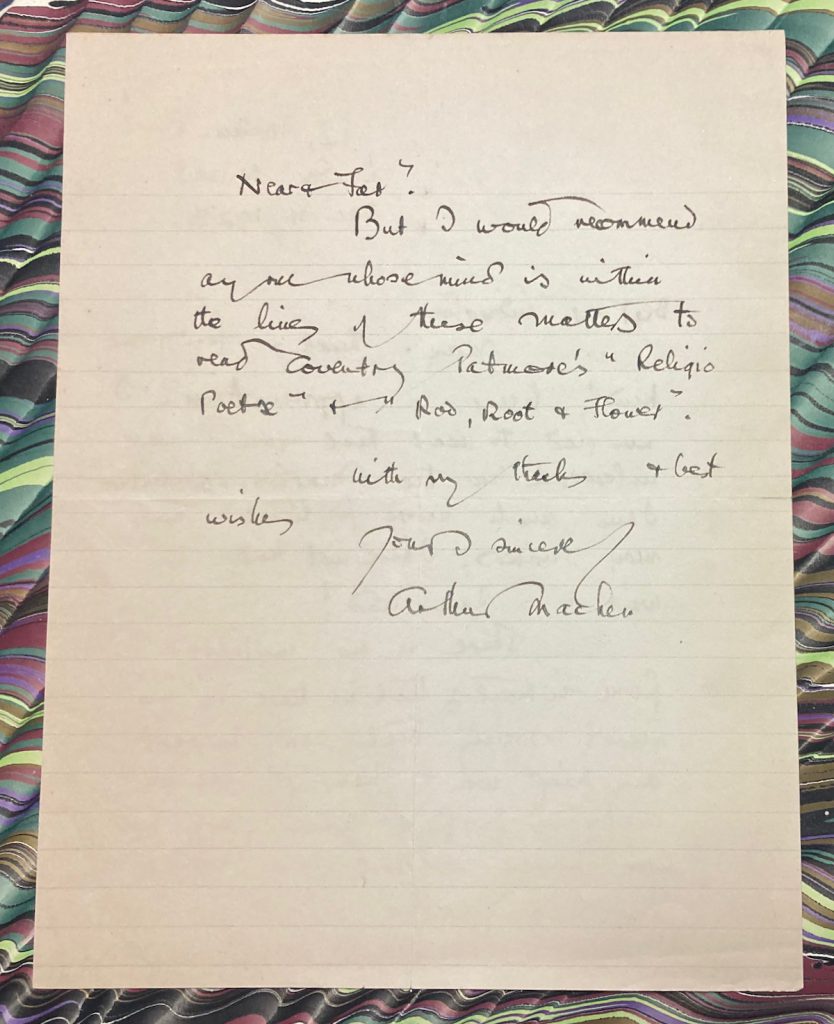
Transcribed in full:
12, Melina Place
London NW8
Dec. 11, 1923
Dear Mr Ludington
Many thanks for your kind letter of appreciation. I am glad to hear that you were interested in the Marks Exhibition. I am more fortunate than many writers. I have not had to wait until I am dead!
There is no initiation from without ; that is, there is no secret society that can impart anything worth hearing. The only initiation is from within, so that you have almost as much as I do, having read “Things Near & Far”.
But I would recommend to any one whose mind is within these lines to read Coventry Patmore’s “Religio Poetae” & “Rod, Root, & Flower”.
With my thanks & best wishes
Yours sincerely
Arthur Machen
“The only initiation is from within” is prime Machen, a generous and spontaneous response to a young worshipper. Ludington seems not to have attempted to continue the exchange and just this one glimpse remains from a century ago.
* Catalog of rare and choice books, first editions of modern authors, etc. Charles Dickens first editions including the renowned Lapham-Wallace copy of the Pickwick papers. Also the most important collection of first editions and original manuscripts of Arthur Machen ever offered. New York: Harry F. Marks, 1923. Goldstone & Sweetser 76b.
Not seen, but noted from the bibliographer’s copy held at HRC (Call no. Z 8230 H355 1923). The Machen items are nos. 202-248. [Images courtesy of HRC.]


** John Gawsworth. The Life of Arthur Machen. Edited by Roger Dobson. Friends of Arthur Machen / Reino de Redonda / Tartarus Press, 2005. Pp. 286, 300, 304.
The chapter endnotes record some of the prices in those far off days, including the manuscript of The Three Impostors at $775. By way of comparison, Marks Catalogue No. 4 (1919), presenting an abundance of curiosa, had listed a finely bound set of Casanova’s Memoirs, now for the first time translated into English (1894), at $250 without mention of Machen as the translator; a similarly bound set of the twelve volumes, with addition of the note [by Arthur Machen], appears in the 1923 catalogue at $200, where a fifteenth-century Flemish manuscript Book of Hours was priced $140. In 1925, Marks moved from lower Broadway to west 47th street and was the U.S. agent or distributor for the Black Sun Press.
Thanks to William Hutcheson who offered me the letter earlier this year.
N.B. This account picks up some threads from an earlier post, Peak Machen : 1923.
Addendum, 14 December: sometimes serendipity brings forth new information. Here is a clipping from the New York Tribune for a Thursday in December 1923 (likely 6 December):
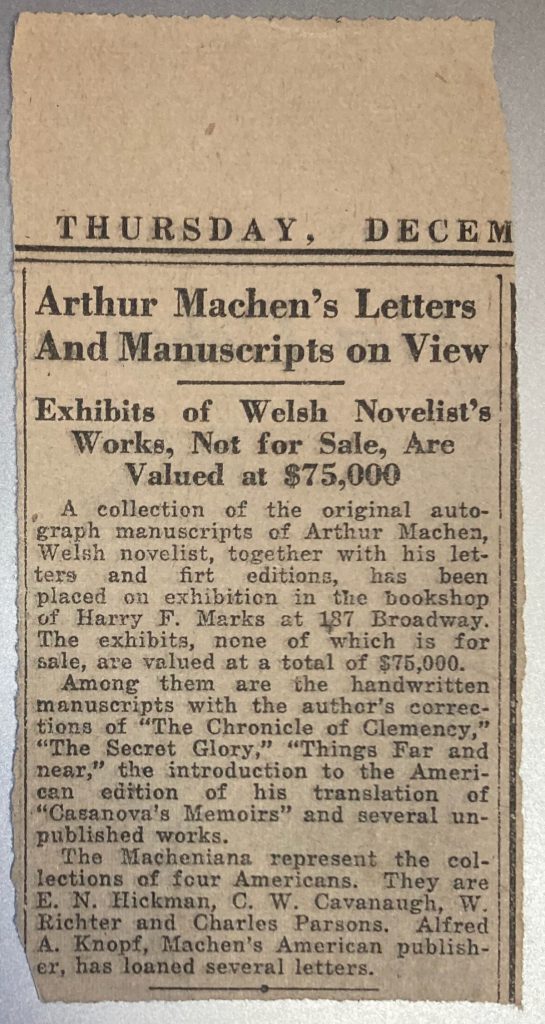
This is a report of the exhibition at the Marks bookshop that prompted Mr. Ludington to write Machen. One can infer that Marks had sold most of the Machen manuscripts by this date. The Charles Parsons collection is now at Yale : it includes the manuscript of “The Garden of Avallanius”, known to us as The Hill of Dreams (Beinecke GEN MSS 256, Series I).

The work of Jorge Luis Borges has always been a touchstone for me: the concision and entanglement of his fictions and artifices and inquisitions are a source of great pleasure and inspiration. I am pleased to report that James Cummins Bookseller catalogue 145, Jorge Luis Borges, is ready, describing more than 400 items from the private collection of Gary Oleson, proprietor with Franny Ness of Waiting for Godot Books in Hadley, Massachusetts. Waiting for Godot were long- time specialists in twentieth century literature (among many other fields), including Latin American authors, and Oleson began buying Borges material in the late 1980s and early 1990s.
The collection includes books owned by Borges, manuscripts of essays and stories, autograph notes, photographs, inscribed books, and a comprehensive group of books, periodical appearances, ephemera, and secondary literature. The cover illustrates a book by Capt. Marryat, signed by Borges at age 11, 25, 33, and 42, and with the ownership signature of his English-born great aunt, who taught him English
As with the writings of Borges, patterns and connections reveal themselves across the pages of the catalogue, which is published on the occasion of a Borges centenary, the hundredth anniversary of the publication of his first book of poems, Fervor de Buenos Aires (1923). [HWW]
Catalogue 145, Jorge Luis Borges is in two sections, an illustrated catalogue of 130 items, and a descriptive listing of 275 items. A printed catalogue is available, and many items will be on display at the New York Antiquarian Book Fair 27-30 April at the Park Avenue Armory, in the Cummins booth A1. Your correspondent will be there, come say hello.
‘You wake up feeling wonderful. But also, in some indefinable way, strange’
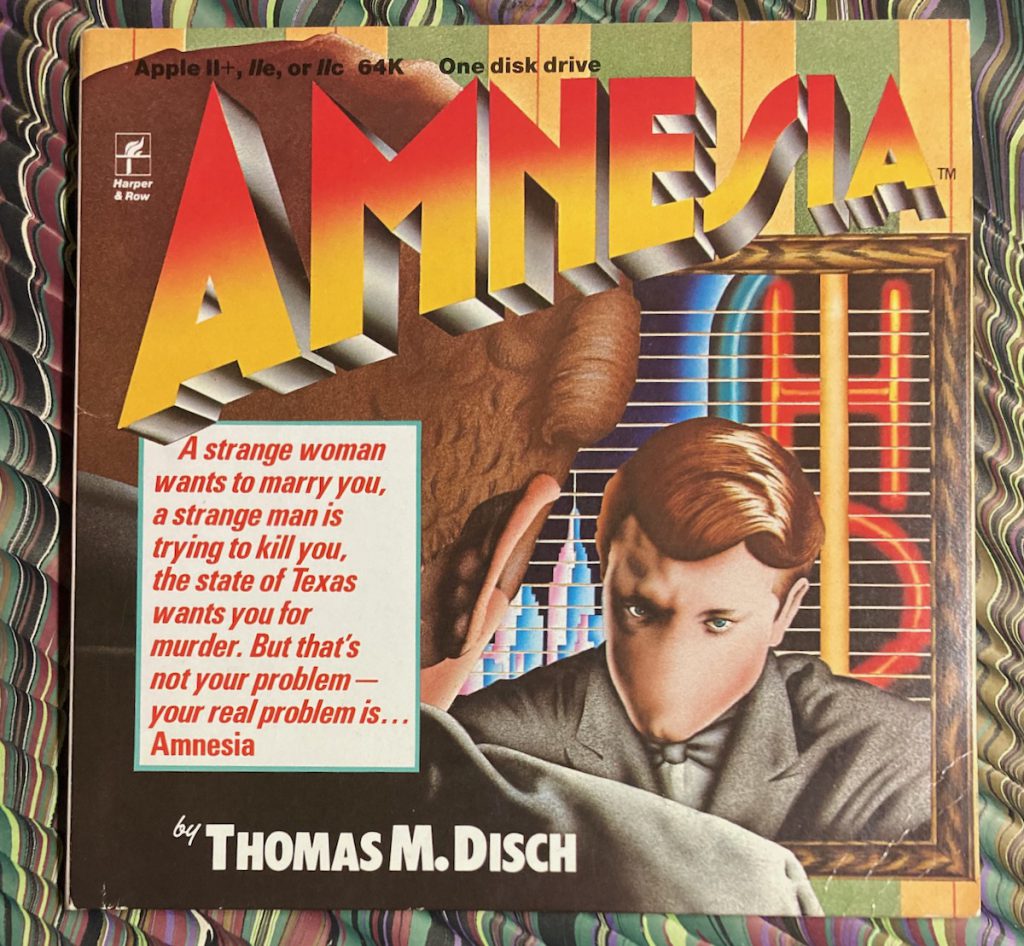
The other day Tom Lecky handed me something he found while tidying up his shop, Riverrun, or more precisely tidying up old stuff from its earlier existence when Chris Stephens ran it as a street-level open shop in Hastings on Hudson. Mr. Lecky (whom I call Tom but in a moment you’ll see why the usage remains formal) knew I’d be interested because when he first took over, I had bought the proof copy of On Wings of Song (1979) marked by Thomas M. Disch with corrections for the Gollancz publication of the novel. What Mr. Lecky handed me was a pictorial printed sleeve for Tom Disch’s early interactive fiction, Amnesia, empty except for a printed map of Streetwise Manhattan (copyright date 1984) with a curious gold sticker on it, “compliments of the Sunderland Hotel” (not a hotel I had ever heard of). The sleeve is undated and bears a Harper ISBN 0-06-668006-9, and is signed by Disch with his formal signature.
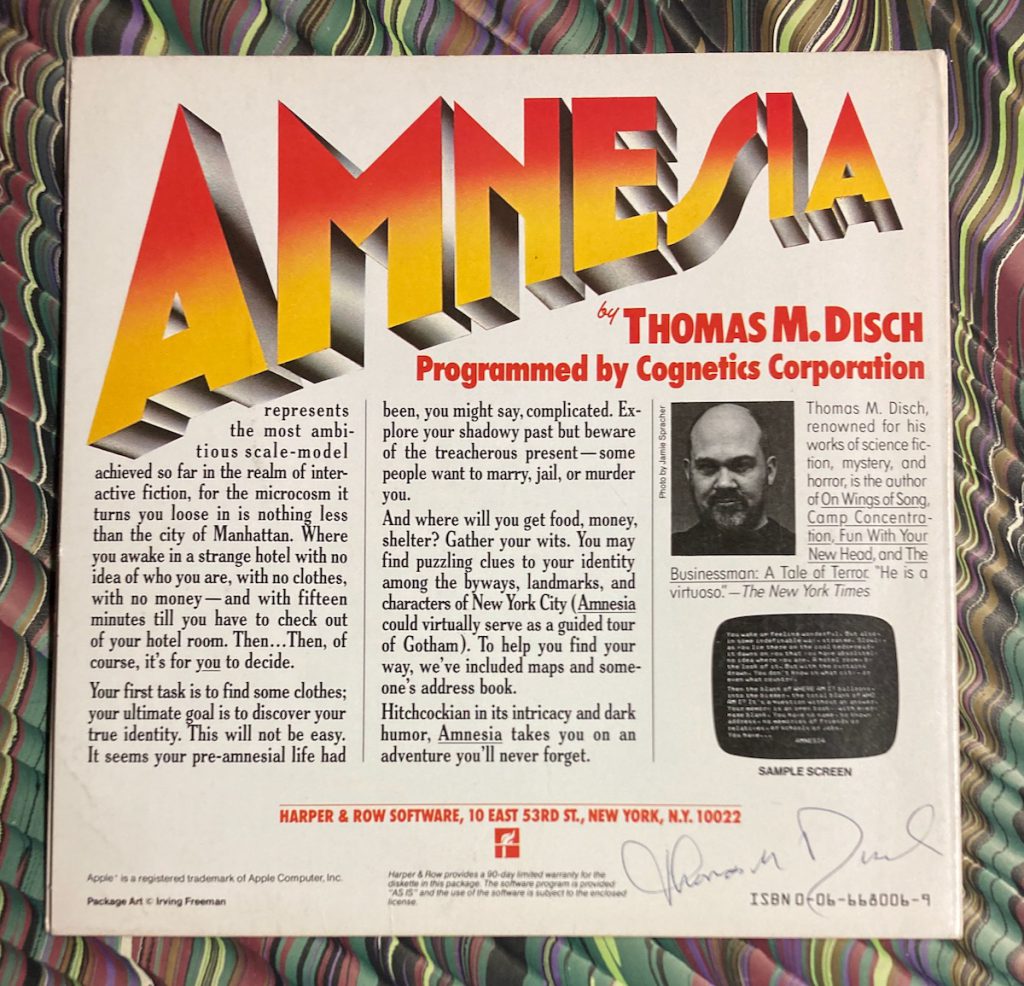
This a trickier object than it might seem at first glance, for it is a bibliographic ghost: the Harper and Row Amnesia by Tom Disch never existed.
In Contemporary Authors Autobiography Series, vol. 4 (Gale Research, 1986), Tom wrote:
I’ve completed a computer-interactive novel, Amnesia, which should appear from Electronic Arts in May of 1986. For a while it was touch-and-go whether Amnesia would ever exist. Harper and Row Software contracted for it in the fall of ’83, and then a year later, when the project was halfway to completion, Harper and Row dissolved their software department before it had put a single product on the market, a decision dictated by considerations of accounting [. . .] and then when Electronic Arts took over Amnesia I returned to work on that. And now that’s done [. . .]
He was indeed a pioneer in this new field and Amnesia is a text of branching paths, beginning when the “player” awakens in a hotel room in the Sunderland Hotel somewhere in Manhattan with, as the Harper sleeve copy says, “no idea of who you are, with no clothes, with no money — and with fifteen minutes until you have to check out of your hotel room.”
The text adventure was published by Electronic Arts in 1986. Interviewed by Larry McCaffery in Across the Wounded Galaxies (1990), Tom observed
When you’re working on this kind of text, you’re operating in an entirely different mode from when you’re writing other forms of literature. [. . .] In a very literal sense, any computer-interactive text deconstructs itself as you write because it’s always stopping and starting and branching off this way and that. You are constantly and overtly manifesting those decisions usually hidden in fiction because, of course, you don’t normally show choices that are ruled out — though in every novel the choices that are not made are really half the work, an invisible presence. With Amnesia, I found myself working with a form that allowed me to display these erasures, these unfollowed paths.
The history of the Harper ghost is also well known. In the fall of 2008, Stephane Racle, a specialist in computer games bought an example of the Harper sleeve and a typescript of Amnesia, the Script for my U-Dun-It, Disch’s text for the interactive adventure.
More recently, Rebooting Electronic Literature: Documenting Pre-Web Digital Media, volume 1 (2018), from the Electronic Literature Lab at Washington State University, Vancouver, includes a section on Disch’s Amnesia with a “traversal” or demonstration of the 1986 Amnesia, with a critical essay and links to reviews and earlier articles.
— — —
current reading :
— Marcel Proust. Albertine disparue [1925]. Gallimard, Bibliothèque de la Pléiade.
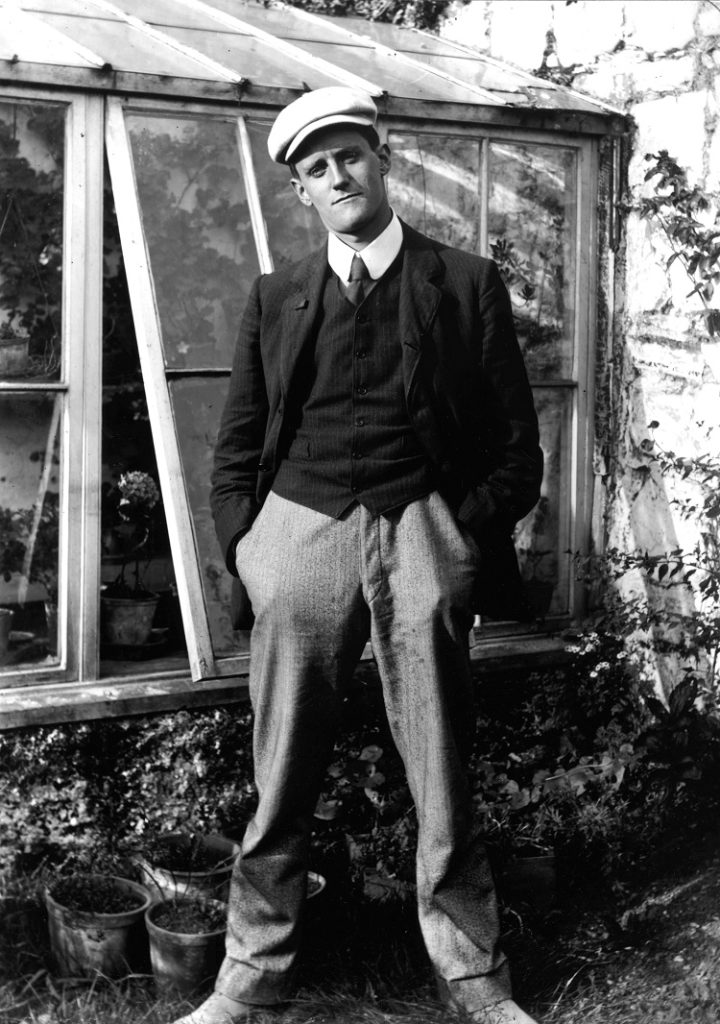
— C. P. Curran. James Joyce Remembered. Edition 2022. With essays by H. Campbell, D. Ferriter, A. Fogarty, M. Kelleher, H. Solterer. Collection presented by E. Roche & E. Flanagan. Illustrated. x, 224 pp. UCD Press, 2022.
— — —
recent reading :

— Stephanie Feldman. Saturnalia. A Novel. Unnamed Press, [2022]. A dark celebration of the mysteries in the streets of a Philadelphia shattered by climate change, epidemics, and political manipulations. Not since In the Drift by Michael Swanwick has the threatening power of the city’s social clubs been summoned so palpably. Though the novel treats with matters of alchemy and magic, the narrative strategy is strongly anchored in mimetic realism.
— George Sims. The Rare Book Game. Holmes Publishing Company, 1985. Collection of essays by English bookseller and mystery novelist George Sims. With the companion volumes, More of the Rare Book Game (1988) and Last of the Rare Book Game (1990). Sims had remarkable access to archives of A. J. A. Symons, Oscar Wilde, Eric Gill, and others, and his discussion of the authors and the materials he handled makes for fascinating reading.
— — —
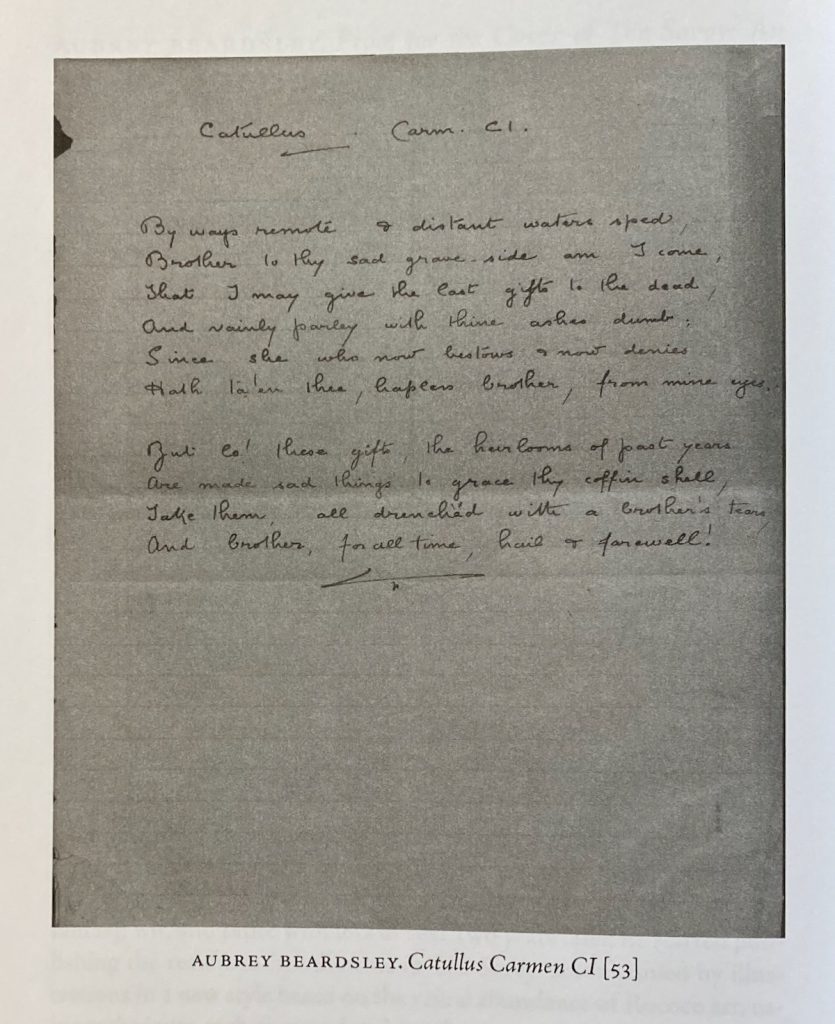 — Margaret D. Stetz. Aubrey Beardsley 150 Years Young. From the Mark Samuels Lasner Collection. 44 illustrations, 69 items. 85 pp. Grolier Club, 2022. Excellent record of the fabulous, witty, and nimbly erudite descriptive labels from the Beardsley exhibition (8 September to 12 November 2022). The translation from Catullus illustrated above suggests that a classical education was not without its rewards. Not being a Latinist, your correspondent is glad that Beardsley could knock out such a poem.
— Margaret D. Stetz. Aubrey Beardsley 150 Years Young. From the Mark Samuels Lasner Collection. 44 illustrations, 69 items. 85 pp. Grolier Club, 2022. Excellent record of the fabulous, witty, and nimbly erudite descriptive labels from the Beardsley exhibition (8 September to 12 November 2022). The translation from Catullus illustrated above suggests that a classical education was not without its rewards. Not being a Latinist, your correspondent is glad that Beardsley could knock out such a poem.
— Rick Moody. Surplus Value Books. Catalog Number 13. Illustrated by David Ford. Unpaginated, [40] pp. [Santa Monica]: Danger Books!, [2002]. Edition of 174 copies signed by the author. An acerbic jeu d’esprit, a pitch perfect catalogue of imaginary books compiled by an obsessive romantic stalker. Originally published in wrappers in different format in 1999.
— Adam Roberts. The History of Science Fiction. Palgrave Macmillan, 2006.
— George Pelecanos. The Night Gardener. Dennis McMillan, 2006.
— Marcel Proust. La Prisonnière [1923]. Gallimard, Bibliothèque de la Pléiade. I have been reading my way through Proust for the last year, slowed down but still going. One thing that has emerged, to my surprise, is how funny the narrator is at times.
— — —
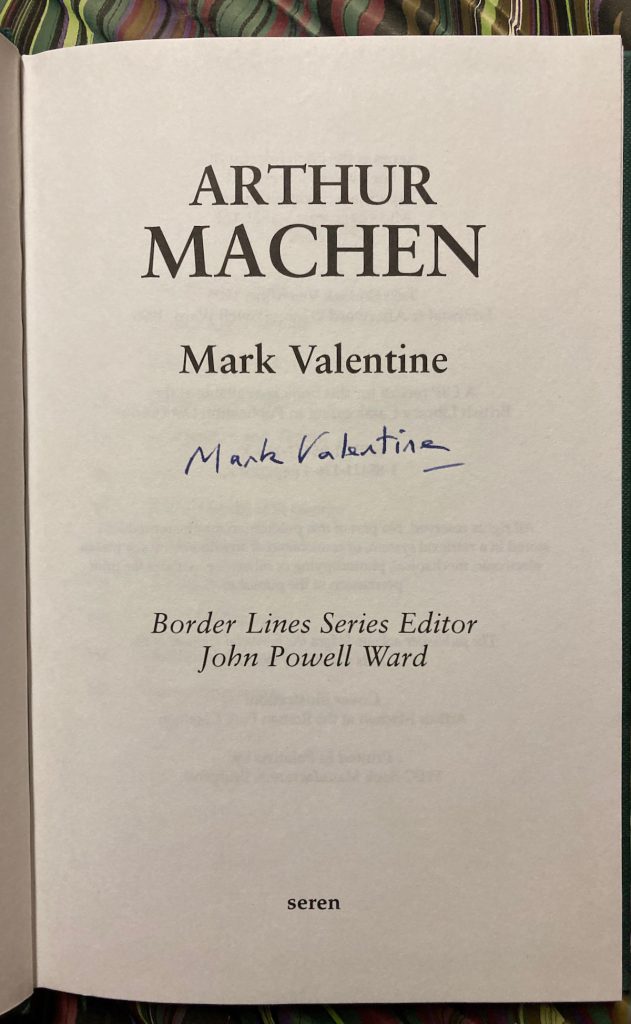
— Mark Valentine. Arthur Machen. Seren, [1995]. Concise biography with an excellent account of the Gwent landscapes of Machen’s youth and their influence upon him.
— Kij Johnson. The River Bank. A sequel to The Wind in the Willows. Illustrations by Kathleen Jennings. Small Beer Press, [2017].
— — —

— The Bart Auerbach Collection. Dedication Copies; Books, Letters & Manuscripts; The Book Trade; Poets, Philosophers, Historians, Statesmen, Essayists, Dramatists, Novelists, Booksellers, Humorists, &c., &c., &c. Riverrun Books, [2022]. An illustrated memorial catalogue of the private collection [500 items] of the dean of New York antiquarian book appraisers.
— — —
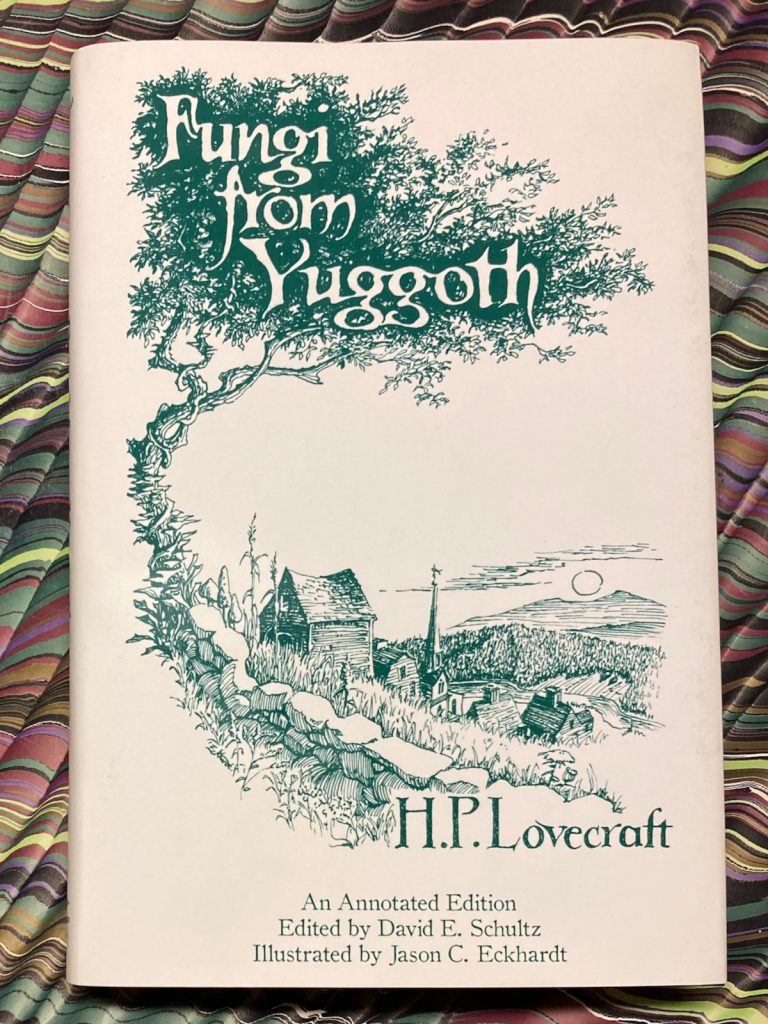
— H. P. Lovecraft. Fungi from Yuggoth. An Annotated Edition. Edited by David E. Schultz. Illustrated by Jason Eckhardt. Hippocampus Press, [2017]. [re-read].
— Francis Brett Young. Cold Harbour. Collins, [3rd ptg, 1926].
— Giuseppa Z. Zanichelli. I codici miniati del Museo Diocesano “San Matteo” di Salerno. Lavegliacarlone, 2019.
— Curzio Malaparte. The Skin. [La Pelle, 1949]. Translated from the Italian by David Moore. Introduction by Rachel Kushner. NYRB paperback.
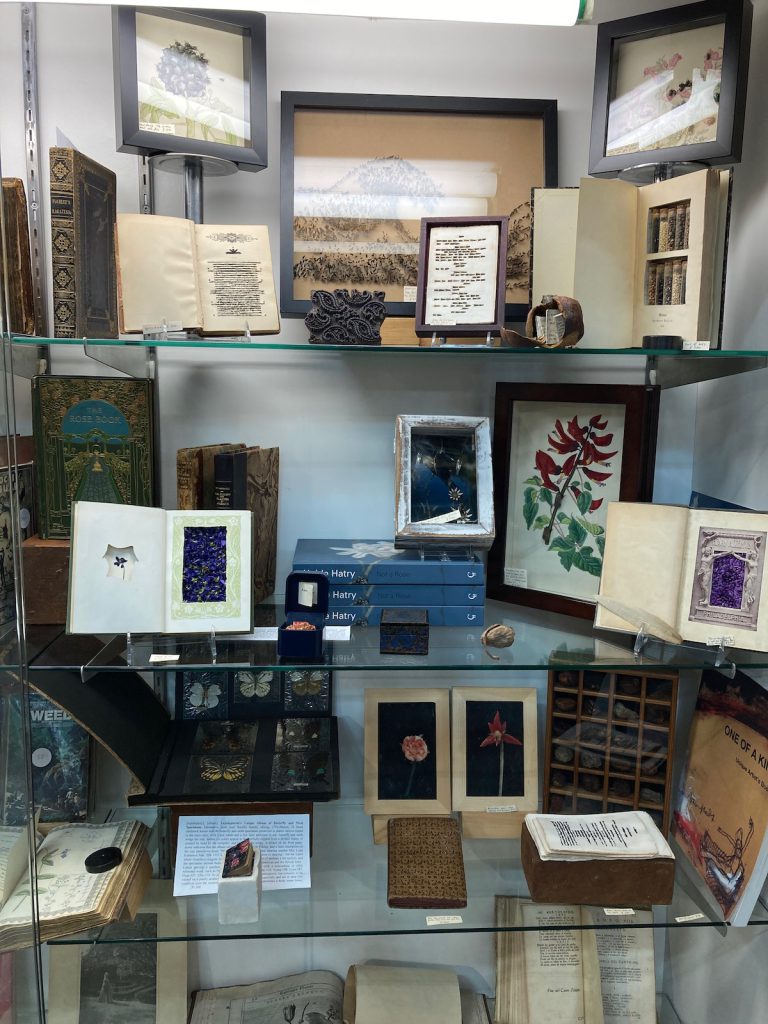
The most striking vitrine I saw at the recent New York Antiquarian Book Fair was this display of the artist books of Heide Hatry and related botanicals at the booth of Sanctuary Books. Hatry’s transformations are playful and provocative, and gorgeous to hold in the hand.
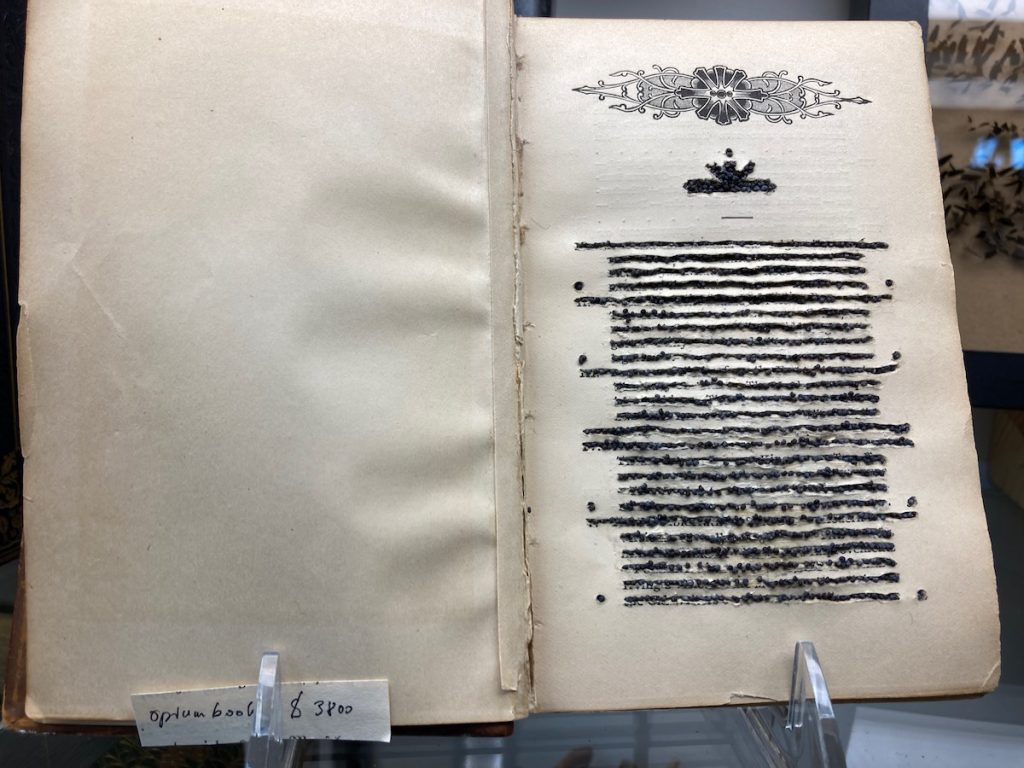
[Opium Book, with poppy seed text.]
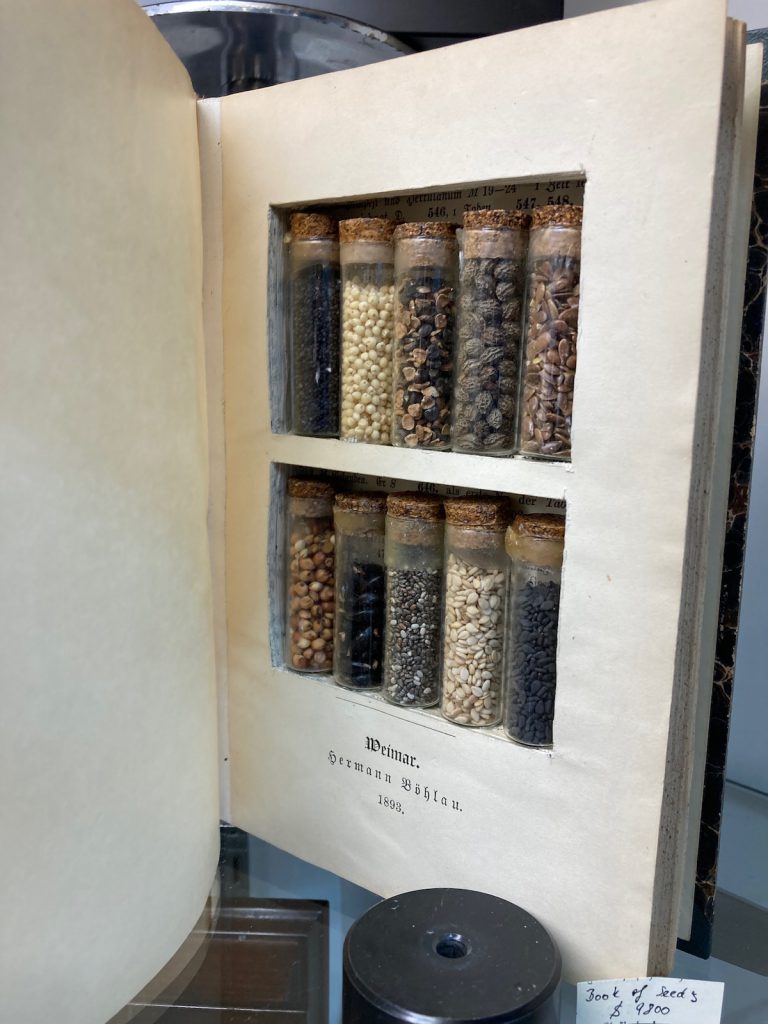
[Book of Seeds]
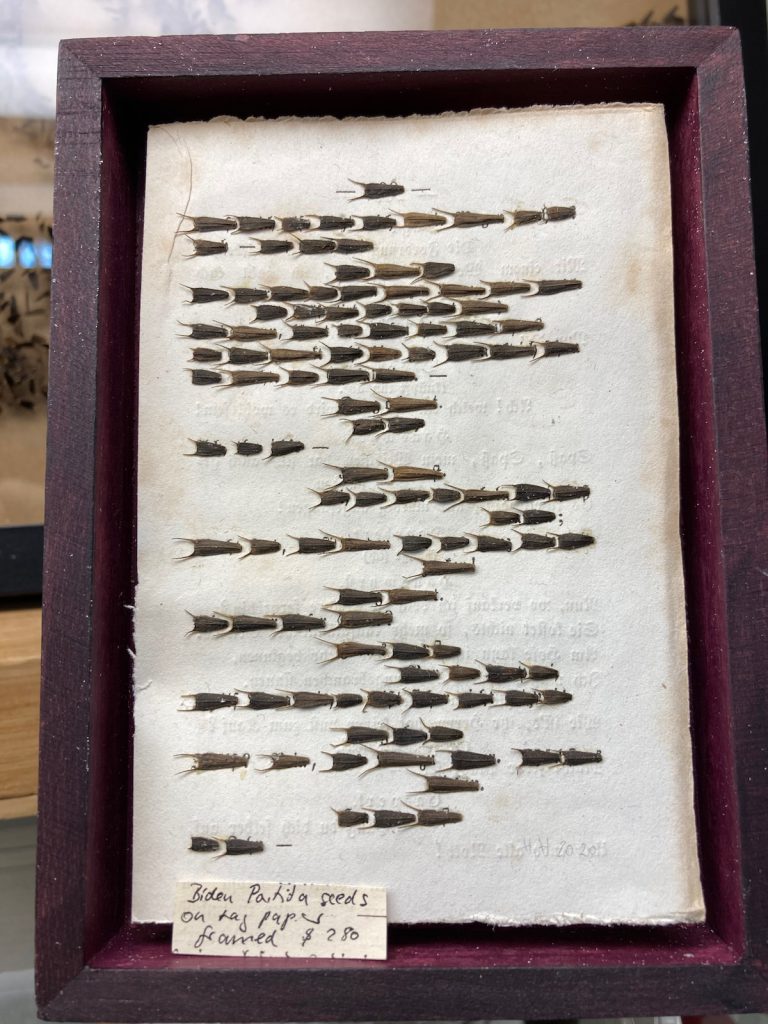
[A prickly text.]

[Secret library in a pomegranate.]